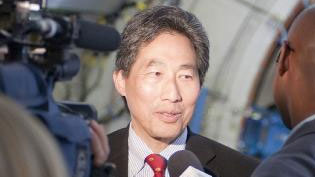Seen from the exterior with its rear canopy closed, the Stratospheric Observatory for Infrared Astronomy (SOFIA) aircraft looks much like a typical jumbo jet you might see at any airport-- perhaps even reminiscent of another well-known, heavily modified Boeing 747, Air Force One.
"SOFIA has a lot of characteristics that are very similar to a normal passenger airplane," explains Erick Young, Director of the SOFIA Science Center at NASA/Ames Research Center in Mountain View, CA. "Except for the fact that we’ve completely gutted the insides, and there’s a hole in the side of the airplane the size of a garage door, and there’s a 17-ton telescope mounted in the back. But other than that it’s pretty much like a regular airplane."
It may appear modest from the outside, but SOFIA is more than a telescope tucked into a re-purposed commercial airliner. Obscured from view is a complete flying astronomical observation platform centered around a 2.7 meter-wide reflecting telescope, which carries a dozen or more astronomers, observers and crew above the clouds to observe objects and phenomena too cold to be seen in visible light.

"The appearance of things that we can see in visible light is primarily because things are hot enough to give off light at visible light wavelengths," says Young. " If you get things too cold, then things look redder and redder and eventually they’re so red that the human eye can’t see them anymore. And then what we are actually sensing is a different kind of light and it’s called infrared. And that’s basically the heat radiation that’s coming from objects. And so what we can look at are not things that are thousands of degrees hot, but things that are hundreds or tens of degrees above absolute zero. And it turns out that there’s a lot of material in the universe- the dust, planets like the Earth, clouds in space. They’re all too cold to normally emit in visible light, but by looking in the infrared, we’re able to sense them, detect them, and measure their properties."
Our most familiar instrument for observing and measuring the electromagnetic radiation emitted by objects, the human eye, senses a narrow range of energy wavelengths. These are waves with wavelengths of 380 nanometers (violet) to about 740 nanometers (red). Although astronomy has its origin in observing the universe in this part of the spectrum, there are also telescopes and instruments that measure incredibly short, energetic wavelengths such as Gamma rays and X-rays, as well as extremely long wavelengths such as radio waves. Infrared or "IR" astronomers study that expansive swath of wavelengths just below the visible range, but still above the radio end of the spectrum.

